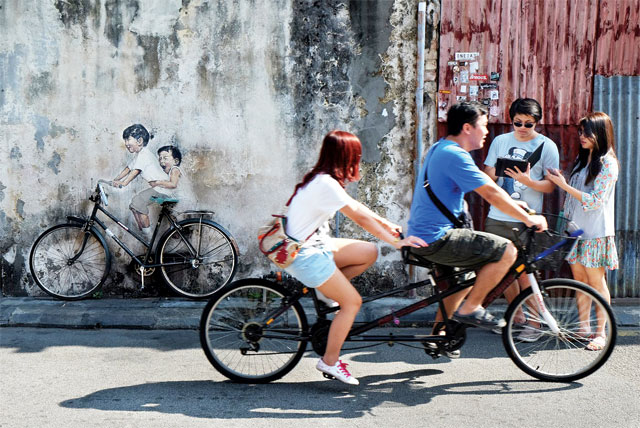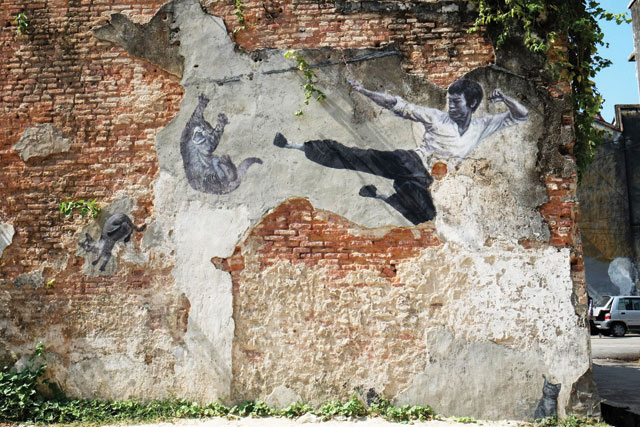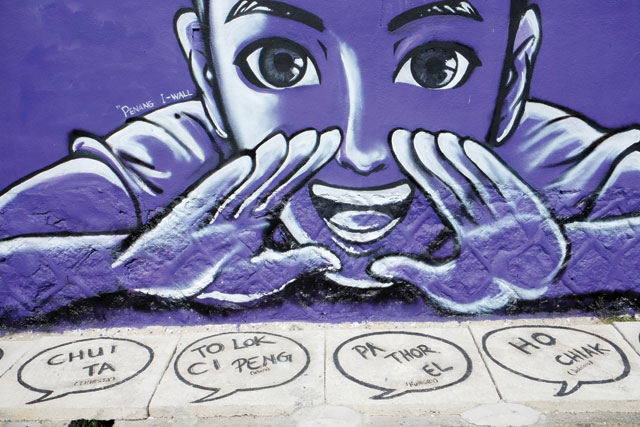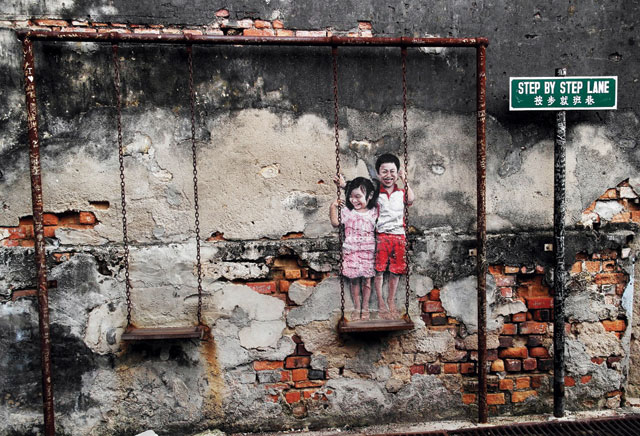Take a stroll down Penang’s Armenian Street on any given weekend or public holiday and it is impossible to dodge the long queues of Malaysian and international tourists. They line up patiently, waiting to get a snap with a realist painting of two kids laughing and riding a bicycle, which is painted on a public wall.

This iconic piece of street art was created in 2012 by 27-year-old Lithuanian Ernest Zacharevic, who was inspired by the Old World charm of George Town. The artist produced a series of six murals, all of them commissioned by Mirrors, an art project that was part of the 2012 George Town Festival, which celebrates Penang’s World Heritage induction every August with a full month of cultural and art events. As locals and tourists swarmed to the locations of the paintings, things soon went viral on social media and Zacharevic’s bicycle mural went on to be selected by the Guardian as one of the world’s best pieces of street art of 2013.
“We never expected such an overwhelming international appreciation,” says Lim Chooi Ping, general manager of George Town World Heritage, the company responsible for the management, monitoring and promotion of the city as a world heritage site. “We simply commissioned art that could appeal to local Penangites’ sensibilities and tastes, and Zacharevic came up with very realistic paintings our people could relate to,” she says.
Today, no visit to Penang is considered complete without a pose and picture with one or more of the murals. Although they slowly fade into the structures they’re painted on, the works have helped to breathe new life into George Town and attract international attention to its historic centre, a place that locals believe to be their island’s living heritage.

“It all started when we decided that the city needed a new life injection,” says Chin Poh Chin, president of the Penang Tourist Guides Association. “George Town and Melaka were recognised by Unesco in 2008, but before the street art trend, it was rare to see young people gather in the heritage zone after dusk. The art transformed George Town from a ghost town into a trendy place to be. We don’t mind using the murals as a promotional façade, so long as it helps people see the real living heritage of George Town.”
Long before George Town came tenth on a Time magazine list that ranked the world’s ‘selfie capitals’, the once bustling seaport was a crucible of cultures and trades that came together in the streets. That particular atmosphere, however, seemed to get lost with the turn of the century and the nation’s swift industrialisation. According to Joe Sidek, the general manager of the George Town Festival, the street art “slows the pace down a bit. People take the time to walk around the heritage area, rather than just see it out of a car window. It gives a more accurate idea of what the word ‘heritage’ means: something living and changing, not a historical artefact confined to a museum.”
Francis Wong, a Mandarin-speaking tour guide who assists several of Penang’s NGOs in running heritage walking tours, has a similar opinion.
“At first, people didn’t know what to do in the ageing streets of George Town,” he says. “But thanks to what started as a mass hunt for the perfect Facebook profile picture, the revamped image of George Town has attracted new tourists. They ask more about the history of Penang’s streets and trades, which are the real heritage here. In fact, each one of Penang’s historical lanes is named after the trades that were once conducted there.”
Street art also provides a creative option for the conservation of the town’s architecture, which is in dire need of restoration. Artists integrate cracked walls into their murals and forward-thinking municipal officers, who encourage such renovation attempts, appreciate their efforts.
Takayuki Miyazono, a truck driver from Okinawa, Japan, arrived in Penang a few months ago and became intrigued by the artistic potential of the place. He decided to contribute by painting on the damaged walls of a public school’s outer perimeter. Using the cracked walls to enhance his depiction of Okinawan mythological figures, a once-unsightly wall was turned into the rock on which his ethereal creatures stand before the sea.
“I want to cover up the whole wall prior to leaving Penang,” says Miyazono as he takes a break from painting. “It’s quite hard to paint around the damaged areas, but once you start with the right idea, holes and cracks can really help an artwork come to life.”
WK Setor, 50, is the latest artist to add colour to Armenian Street. He has been working on finishing a piece on the façade of the Ming Xiang Tai chicken rice shop, a few hundred metres from the iconic bicycle painting. The shop’s vendors bought the vintage bicycle he inserted into the wall and a cheeky portrait of their children trying to steal some baozi from the bicycle’s basket completes Setor’s mural.
“To paint on the historical heritage district’s walls, one must apply to the Penang Municipal Council to get approval by presenting details on the mural design, composition and purpose,” Setor says. “It is particularly important to state what paint pigments will be used, as they won’t let us damage the original walls.”
Lim Chooi Ping of George Town Heritage explains the restrictions: “After Louis Gan painted two successful murals without asking for permission, we had to set some rules, or anyone could have just started to paint the heritage area’s walls without control. There must be suitable space: The mural’s dimensions, artwork and the potential street congestion that tourists could bring are all factors to evaluate before approval. Also, we only allow watercolour paints, as they don’t damage the buildings and they fade away with time,” she says.
The authorities’ efforts to contain Penang’s street-art phenomenon seem fair, though, with the revenue it brings to the tourism industry and local businesses, the trend is likely to continue for a while yet. And given the limited lifespans of the paintings, there is continued anticipation over what will next adorn George Town’s heritage canvas.
“It’s pretty exciting and refreshing, isn’t it?” asks Lim Chooi Ping with a smile. Judging by the number of people who are drawn to Penang’s heritage zone every day, thousands agree.






